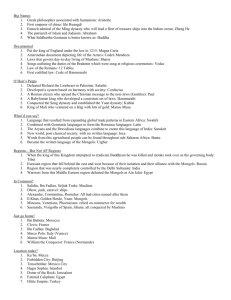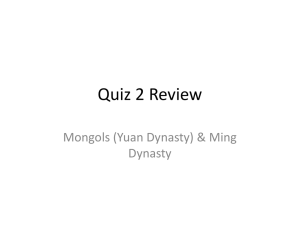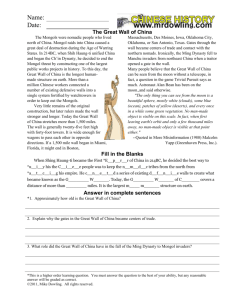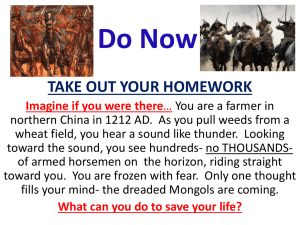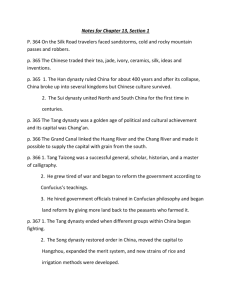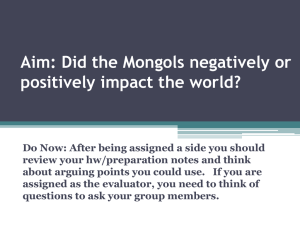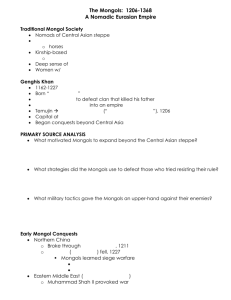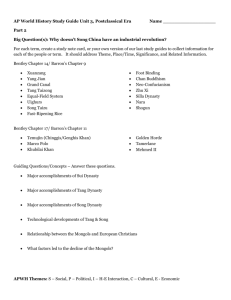Chapter 13
advertisement
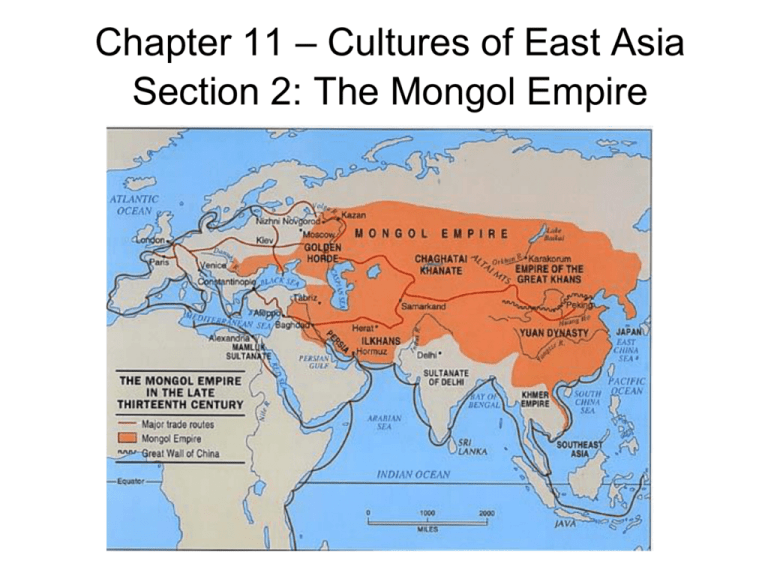
Chapter 11 – Cultures of East Asia Section 2: The Mongol Empire The Mongols were tough, skilled warriors who lived in the saddle. They could travel for days at a time on their shaggy ponies, drinking mare's milk and eating only a few handfuls of grain. They were also considered the most skilled horse riders in the world. About 1200, the Mongols burst out of Central Asia to conquer an empire stretching across Asia and Europe. In the process, they overran Song China and imposed Mongol rule on its people. Section 2 - The Mongol Empire Main Idea The Mongols built a vast empire across much of Asia, founded the Yuan dynasty in China, and opened China and the region to greater foreign contacts and trade. Objectives • How did the nomadic Mongols build an empire? • How did China change under the Mongol rulers of the Yuan dynasty? • Why did the Yuan dynasty decline and finally end? I. The Mongols c.1200 AD - Mongols came from central Asia to create largest land empire in history I. The Mongols Mongols were nomadic warring clans led by a khan; they herded horses, sheep, goats on steppes north of China I. The Mongols 1206 -Temujin united clans; took name Genghis Khan; began campaign of conquest Mongolians unveiled a statue of Khan in Ulan Bator in 2006 to mark the 800th anniversary of his rise to power I. The Mongols Used brutality, terror – Cavalry burned towns, killed citizens, spread fear; people surrendered without a fight I. The Mongols Faced problems when attacking China; Chinese and Turkish military experts taught siege warfare, use of gunpowder I. The Mongols 1227 - Genghis Khan died; empire divided into four khanates; Great Khan ruled over all I. The Mongols 1240 - Batu invaded Europe with Golden Horde I. The Mongols Batu learned of Great Khan’s death and turned back, sparing Western Europe I. The Mongols Mongols ruled peacefully - tolerated local beliefs and ways of life but demanded tribute I. The Mongols Established period of peace and order - the Pax Mongolia, or Mongol Peace I. The Mongols Political stability set the stage for economic growth; trade flourished across Eurasia I. The Mongols Cultural diffusion increased - foods, tools, inventions, ideas all spread with trade II. The Yuan Dynasty 1279 - Kublai Khan defeated Song Dynasty; ruled China, Korea, Tibet, and Vietnam II. The Yuan Dynasty Kublai adopted a Chinese name for his dynasty, the Yuan II. The Yuan Dynasty Kublai ruled from Beijing, extended Grand Canal, fostered trade with India and Persia The Grand Canal of China is the world's oldest and longest canal, far surpassing the next two grand canals of the world: Suez and Panama Canal. The building of the canal began in 486 B.C. during the Wu Dynasty. It was extended during the Qin Dynasty and finished by the Sui Dynasty from AD 605-610. The canal is 1,114 miles long with 24 locks and more than 60 bridges. II. The Yuan Dynasty Marco Polo visited China during Yuan dynasty; stayed for 17 years Marco Polo (1254 –1324) II. The Yuan Dynasty Polo wrote about China’s wealth and splendor; astonished readers in Europe II. The Yuan Dynasty Polo's reports sparked European interest in riches of Asia Silk Scarfs Star Anise, Black & White Pepper, Red Chiles, Cinamon and Bay Leaves III. End of the Yuan Dynasty Yuan dynasty weakened; one cause - military defeats in SE Asia and Japan’s kamikaze III. End of the Yuan Dynasty 1294 - Kublai died; weak successors, floods, famine and rebellion; 1368 Yuan overthrown Huang He (Yellow River) – “China’s Sorrow”


